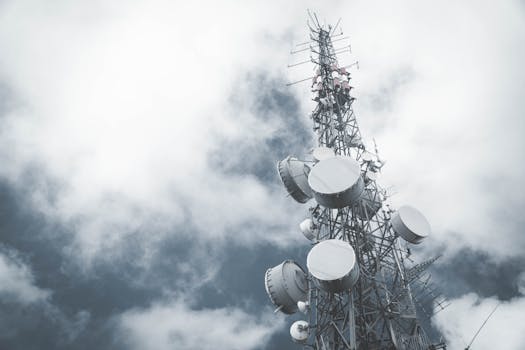
The New Frontier: Exploring the Latest Trends in Satellite Communication. The latest trends in satellite communication are revolutionizing the way we connect and communicate. With advancements in technology, satellite communication is becoming more efficient, reliable, and accessible. Satellite communication has come a long way since its inception, and today it plays a vital role in various industries such as navigation, weather forecasting, and remote sensing.
Satellite communication involves the use of artificial satellites to transmit and receive data from one point to another. The process involves a network of satellites orbiting the earth, which receive and retransmit signals to and from earth stations. This technology has enabled global communication, navigation, and remote sensing, and has transformed the way we live and work. One of the latest trends in satellite communication is the development of small satellites, also known as miniaturized or cube satellites. These satellites are smaller, lighter, and less expensive than traditional satellites, making them more accessible to a wider range of users.
Another trend in satellite communication is the use of high-throughput satellites (HTS). HTS satellites have a higher capacity to transmit data than traditional satellites, making them ideal for applications such as broadband internet, video streaming, and remote sensing. The use of HTS satellites has increased significantly in recent years, driven by the growing demand for high-speed internet and video streaming services.
In addition to these trends, there is also a growing interest in the use of laser communication in satellite communication. Laser communication involves the use of laser beams to transmit data between satellites and earth stations. This technology has the potential to provide higher data rates and more secure communication than traditional radio frequency (RF) communication.
The latest trends in satellite communication are not limited to technological advancements. There is also a growing focus on the commercialization of satellite communication, with many companies investing in satellite-based services such as satellite broadband, satellite navigation, and satellite remote sensing. The commercialization of satellite communication has the potential to make satellite-based services more accessible and affordable to a wider range of users.
However, despite the many advancements and trends in satellite communication, there are still several challenges that need to be addressed. One of the major challenges is the issue of space debris, which refers to the accumulation of defunct satellites, rocket parts, and other objects in earth’s orbit. Space debris poses a significant threat to the safety and sustainability of satellite communication, and efforts are being made to mitigate this problem.
In conclusion, the latest trends in satellite communication are transforming the way we connect and communicate. With advancements in technology, satellite communication is becoming more efficient, reliable, and accessible. As the demand for satellite-based services continues to grow, it is likely that we will see even more innovative trends and developments in the field of satellite communication.
The future of satellite communication holds much promise, with many experts predicting that it will play an increasingly important role in the development of Internet of Things (IoT) applications, such as smart cities, autonomous vehicles, and industrial automation. As satellite communication continues to evolve, it is likely that we will see new and innovative applications of this technology, and it will be exciting to see how it transforms our lives and workplaces in the years to come.
Furthermore, satellite communication is also expected to play a critical role in the development of 5G networks, which will require a combination of terrestrial and satellite-based infrastructure to provide high-speed, low-latency communication services. The integration of satellite communication with 5G networks will enable a wide range of new applications, including massive machine-type communications, ultra-reliable low-latency communications, and enhanced mobile broadband.
In addition to its technical applications, satellite communication is also expected to have a significant impact on the economy and society. According to a report by NSSTC, the global satellite industry is expected to reach $1 trillion by 2025, with the satellite communication sector accounting for a significant share of this growth. The report also notes that the satellite industry is expected to create thousands of new jobs and stimulate economic growth in a wide range of sectors, from telecommunications to finance.
Overall, the latest trends in satellite communication are transforming the way we connect and communicate, and are expected to have a significant impact on the economy and society in the years to come. As the technology continues to evolve, it is likely that we will see new and innovative applications of satellite communication, and it will be exciting to see how it transforms our lives and workplaces in the years to come.
Despite the many benefits and opportunities presented by satellite communication, there are also several challenges that need to be addressed. One of the major challenges is the issue of orbital congestion, which refers to the accumulation of satellites and other objects in earth’s orbit. Orbital congestion poses a significant threat to the safety and sustainability of satellite communication, and efforts are being made to mitigate this problem.
Another challenge facing the satellite communication industry is the issue of regulatory framework. The regulatory framework for satellite communication is complex and often fragmented, with different countries and regions having different rules and regulations. This can create challenges for companies operating in the satellite communication sector, and efforts are being made to develop a more harmonized and streamlined regulatory framework.
In conclusion, the latest trends in satellite communication are transforming the way we connect and communicate, and are expected to have a significant impact on the economy and society in the years to come. While there are several challenges that need to be addressed, the benefits and opportunities presented by satellite communication make it an exciting and rapidly evolving field.





